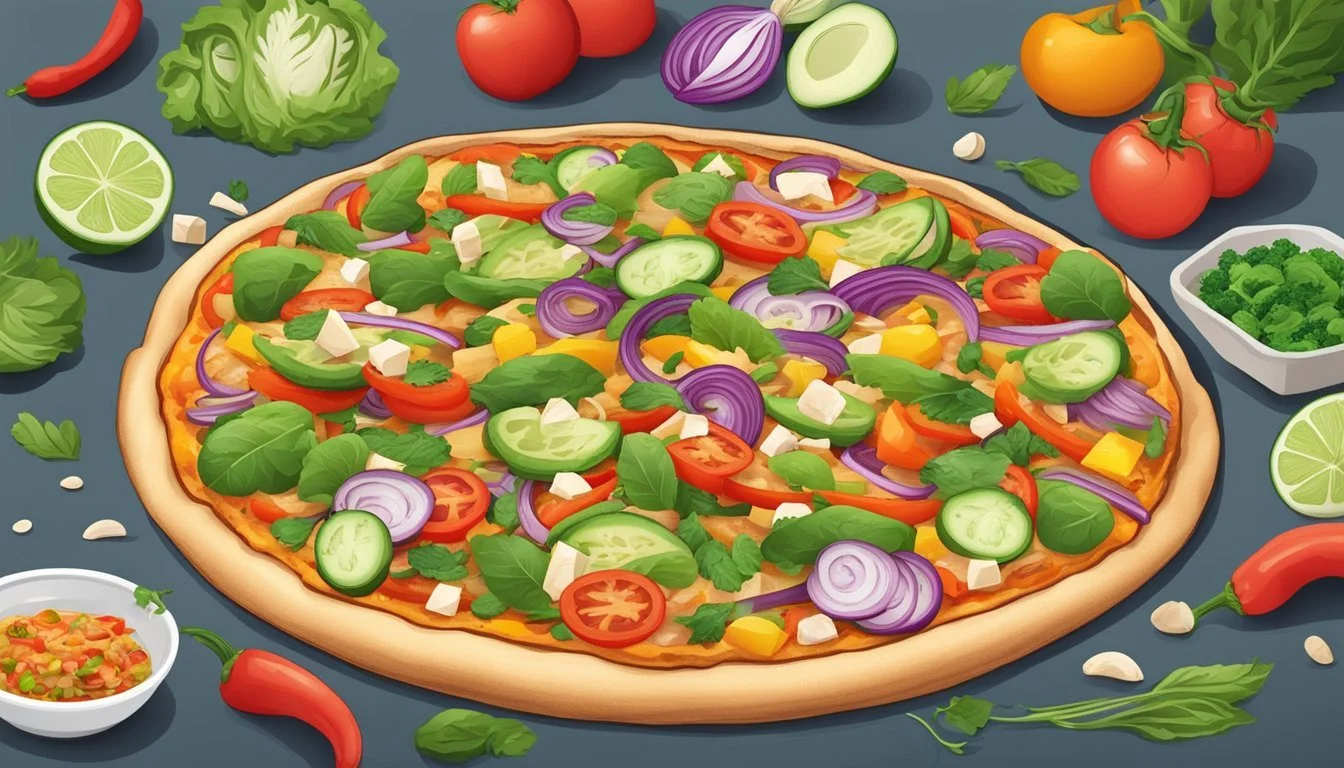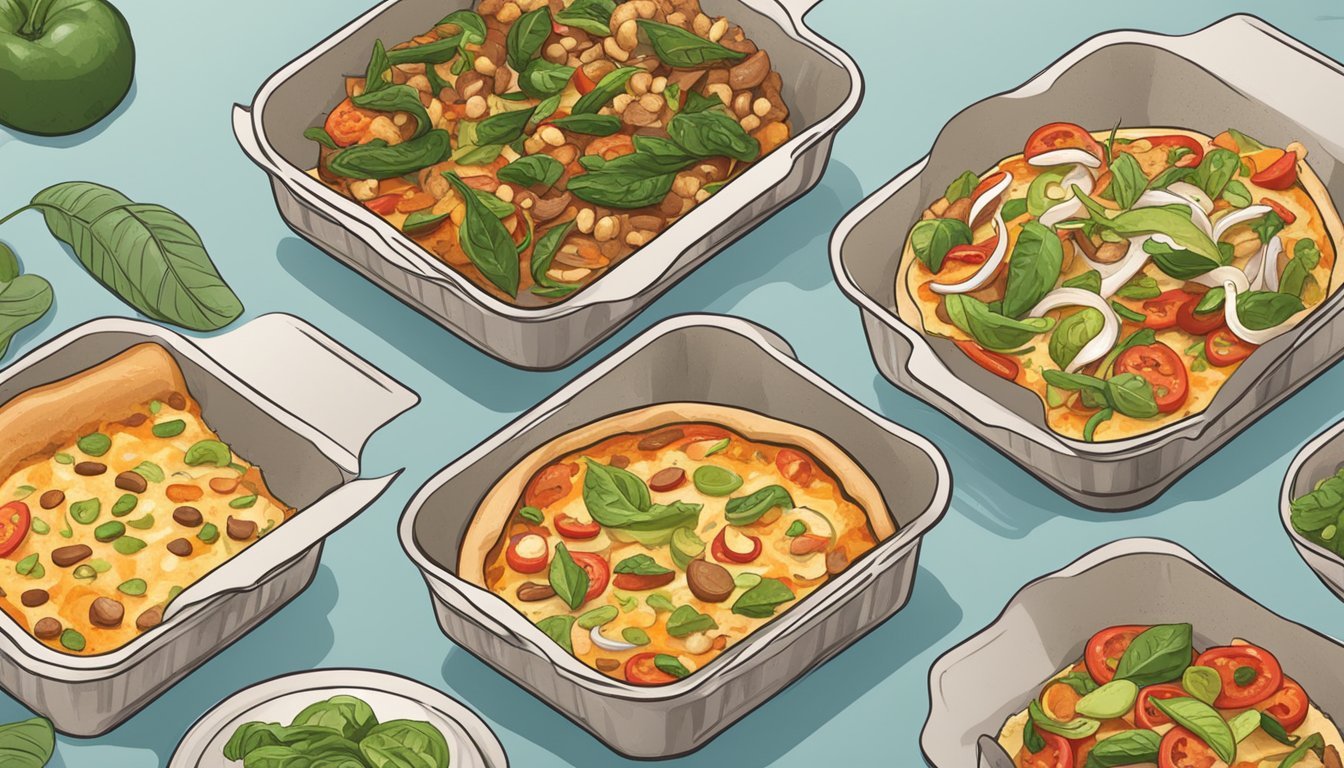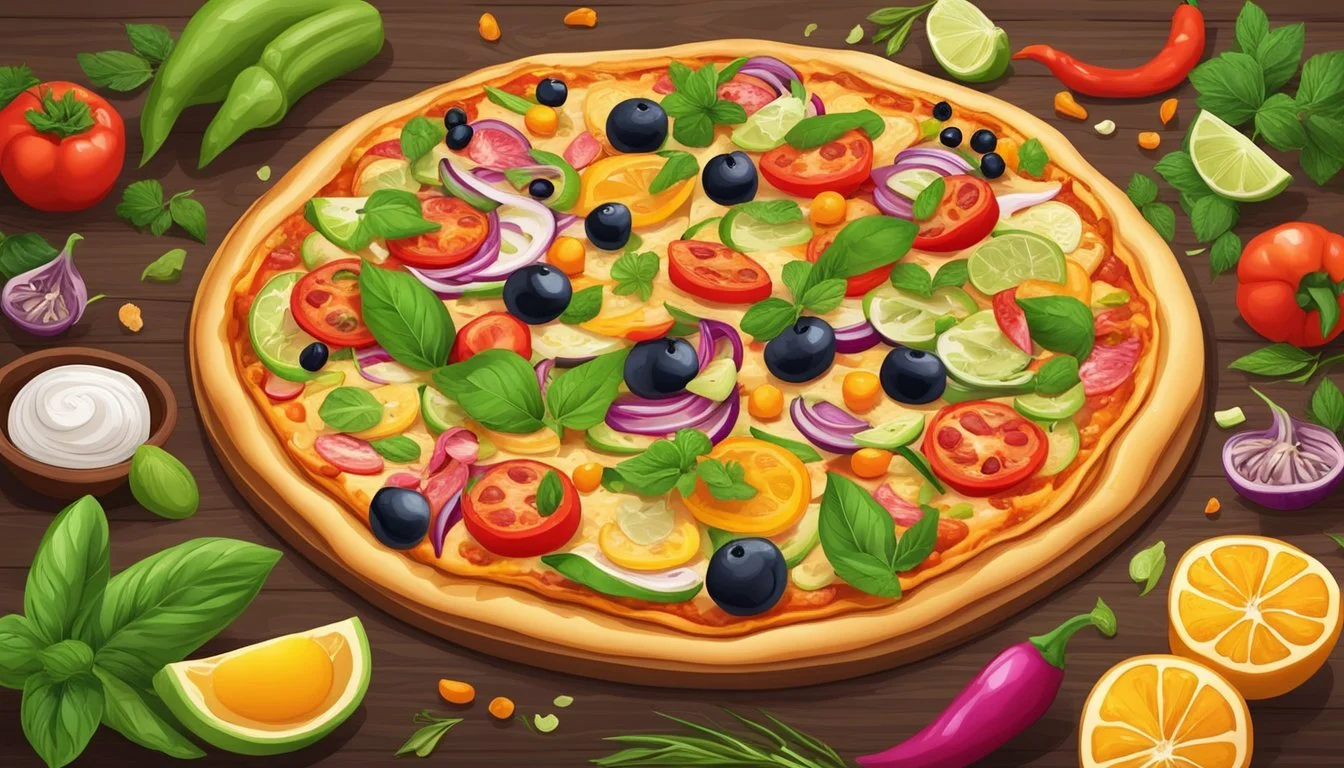Is Thai Pizza Vegan?
Uncovering the Ingredients
Understanding whether Thai pizza (What wine goes well with pizza?) can be vegan requires first examining the components that make up a typical Thai pizza. At its core, Thai pizza is a fusion dish that combines elements of traditional Thai cuisine with the Western concept of a pizza. Thai pizzas often feature flavors like peanut, ginger, coconut, and tofu, alongside other regional ingredients such as cilantro, lime, and spicy curry pastes. Because traditional pizzas include cheese, the vegan status of Thai pizza depends on whether or not animal-derived products are used in its toppings, sauce, and crust.
The fusion nature of Thai pizza means that the base and toppings can be adjusted to cater to different dietary needs, including a vegan diet. A vegan Thai pizza would substitute dairy cheese with non-dairy cheese or omit it entirely and ensure that the crust is made without any animal products such as butter or eggs. The sauces and toppings would also steer clear of non-vegan ingredients, utilizing plant-based proteins like tofu instead of meat and ensuring that any added sauces or condiments are free from animal derivatives.
Restaurants and recipes may vary when it comes to preparing Thai pizza, and the inclusion of vegan options is becoming more common. With the growing demand for plant-based meals, many establishments now offer vegan-friendly versions of Thai pizza, using creative plant-based substitutes to capture the essence of Thai flavors. For those cooking at home, multiple recipes guide the preparation of vegan Thai pizzas, ensuring that the rich, savory, and sometimes spicy notes of Thai cuisine can be enjoyed on a pizza that adheres to vegan dietary preferences.
Understanding a Thai Pizza
Thai pizza is a fusion dish that innovatively combines the characteristic elements of traditional Thai cuisine with the universally loved pizza format.
Ingredients Typical in Thai Pizza
The base of any pizza, including Thai pizza, is the pizza crust or pizza dough. Thai pizza often incorporates either a classic crust or a gluten-free alternative to cater to dietary preferences. A variety of vegetables such as carrots, onion, green onions, (What wine goes well with onions?) broccoli, and red bell pepper are common toppings that add crunch and nutritional value. Proteins like tofu, often marinated or seasoned, provide a meat-free topping that aligns with a vegan diet. Traditional Thai ingredients such as bean sprouts, chopped peanuts, and sometimes cauliflower or mushrooms can also be featured.
Bold flavors are key in Thai pizza, as they are in Thai food (What wine goes well with Thai food?) generally. Instead of tomato-based sauces, (What wine goes well with tomato-based sauces?) a peanut sauce, typically made with creamy peanut butter, flavorful garlic, spicy ginger, and tangy lime juice serves as the pizza's flavor foundation. The use of cilantro as a garnish brings a fresh, herbaceous note that is quintessentially Thai.
Distinctive Thai Pizza Flavors
Thai pizza is distinguished by its unique blend of flavors, which are both bold and balanced:
Sweetness comes from ingredients like agave or a touch of sugar, enhancing other flavors.
Saltiness and umami are introduced through soy sauce, a common ingredient in Thai cooking.
Sour notes are usually achieved with lime juice, which adds a refreshing zing.
Heat might be delivered by adding fresh or dried chili peppers, catering to those who appreciate a bit of spice.
Aromatic herbs like cilantro contribute a burst of freshness, while roasted peanuts may be sprinkled on top for an extra layer of texture and nutty taste.
Thai pizza offers a delectable experience for those seeking a vegan option without sacrificing the complexity of flavors associated with Thai cuisine.
Examining Vegan Pizza Foundations
When creating a vegan Thai pizza, one must carefully consider both the base, which includes the crust and sauces, and the array of toppings used to ensure they align with vegan dietary standards.
Vegan Pizza Crust Options
Traditional pizza dough typically comprises flour, water, yeast, and salt, making it inherently vegan. However, for those seeking a gluten-free alternative, gluten-free pizza dough can be made using a variety of flour substitutes such as rice flour, almond flour, or a pre-made gluten-free blend. It's vital to verify that the dough's additional ingredients, like sugar or flavor enhancers, adhere to strict vegan standards.
Examples of Vegan Crusts Include:
Whole wheat flour dough
Gluten-free blends
Cauliflower crusts (ensure no dairy additives)
Alternative Vegan Toppings
Transitioning to toppings, peanut sauce is a popular condiment in vegan Thai pizza recipes that brings a rich, savory flavor to the dish without any animal-derived ingredients. The preparation of peanut sauce generally involves combining peanut butter with coconut milk, soy sauce, and various spices.
Common Vegan Topping Options:
Sauces: Peanut sauce, tomato-based sauces, vegan pesto
Vegan Cheeses: Nutritional yeast, cashew cheese, store-bought vegan cheese alternatives
Vegetables: A mix of traditional and Thai-inspired options such as bell peppers, carrots, and sprouts
Proteins: Tofu, tempeh (What wine goes well with tempeh?), or seitan (What wine goes well with seitan?) can serve as substantial meat substitutes
Plant-based toppings are diverse and allow for customization based on personal taste and availability of ingredients. When selecting toppings, it’s essential to combine textures and flavors that complement each other while ensuring all components meet vegan criteria.
Key Ingredients of Vegan Thai Pizza
A vegan Thai pizza is a dynamic fusion dish combining traditional Italian pizza elements with Thai-inspired flavors. This section will explore the essential components, such as plant-based proteins and alternative sauces and cheeses that make Thai pizza suitable for a vegan diet.
Tofu and Tempeh as Protein Choices
Tofu and tempeh stand at the forefront as the protein choices for vegan Thai pizza. Tofu is often marinated in a blend of peanut butter sauce, tamari (a gluten-free soy sauce alternative), sesame oil, and sriracha sauce, then cooked until it achieves a golden-brown color. On the other hand, tempeh can also be used for its nutty flavor and firmer texture.
Vegan-Friendly Sauce Variations
The sauce for a Vegan Thai Pizza deviates from the traditional tomato base, employing a rich peanut sauce or a coconut milk-infused concoction. Peanut sauce often combines smooth peanut butter, soy or tamari sauce, and additional seasonings like garlic and lime juice to create a balance of sweet, savory, and tangy flavors. For those with nut allergies, alternative bases such as a seasoned tomato sauce or a sesame seed paste mixture can be employed.
Dairy-Free Cheese Alternates
To replace the dairy cheese, vegan Thai pizzas utilize vegan cheese options made from ingredients like nuts, soy, or root vegetables. These alternatives aim to replicate the creamy, melty texture of cheese and are often available in varieties like mozzarella and cheddar. To heighten the Thai flavor profile, dairy-free cheese can sometimes be seasoned with herbs and spices common to Thai cuisine.
Note: When choosing toppings, individuals can customize their pizza with a variety of vegetables such as carrots, red onion, green onions, bean sprouts, peppers, mushroom, and cauliflower. These not only contribute to the nutritional value but also add fresh, vibrant layers of taste and texture to the pizza.
Preparation Tips for Thai Pizza
To create an authentic and flavorful vegan Thai pizza, one needs to focus on the selection of the right ingredients and master certain cooking techniques. The preparation process is crucial to ensure that all the flavors blend harmoniously while adhering to vegan dietary restrictions.
Creating the Perfect Vegan Thai Pizza
Ingredients:
Dough: Preparing a homemade dough with yeast, salt, and water can greatly elevate the pizza. For convenience, one can use a premade vegan crust.
Peanut Sauce: Crafting a rich peanut sauce involves a mix of peanut butter, soy sauce, lime juice, ginger, garlic, and a sweetener such as agave or maple syrup. Adjust salt and a hint of chili flakes for a balanced flavor profile.
Toppings: Opt for a variety of fresh vegetables like carrots, green onions, and peppers. Vegan cheese can be added for texture, and tempeh or tofu for protein.
Garnishes: Finish with fresh cilantro and a sprinkle of red pepper flakes for an aromatic touch.
Preparation:
Start by mixing your peanut sauce to allow the flavors to mingle.
Slice your vegetables thinly to ensure they cook evenly on the pizza.
Precook toppings like tofu or tempeh until golden brown to add a satisfying crunch.
Cooking Techniques and Tricks
Techniques:
Baking: Preheat your oven to the highest temperature for a crispier crust. Bake your pizza in the middle rack using a pizza stone or a perforated pan.
Layering: Layer peanut sauce first, follow with vegan cheese, and arrange tofu and vegetables on top to prevent sogginess.
Tricks:
To retain moisture in the crust, brush the edges with olive oil before baking.
For a more golden-brown finish on vegan cheese, broil the pizza for the final 1-2 minutes.
Let the pizza sit for a couple of minutes after baking for the slices to hold together when serving.
Customizing Vegan Thai Pizza
Crafting a Vegan Thai Pizza allows for a delightful exploration of flavors and textures, with the versatility to adjust toppings according to personal preference or seasonal availability.
Topping Combinations and Variations
When it comes to toppings, the base often consists of a rich peanut sauce which can be made by blending peanut butter with flavors such as garlic, lime juice, and soy sauce. Tofu is a popular protein choice, which can be pre-cooked or marinated for additional flavor. For vegetables, options abound:
Carrots and green onions add a fresh crunch.
Red peppers and bean sprouts provide a sweet and earthy balance.
Cauliflower can be roasted with peanut sauce for a hearty addition.
To diversify the toppings, one might consider:
Sautéed mung bean sprouts for a nutty taste.
A sprinkle of chopped or crushed peanuts for extra crunch.
Adding cilantro for an aromatic lift and a pop of color.
A drizzle of sriracha or peanut butter sauce for an extra kick.
All About Vegan Pizza Toppings
The art of topping a Vegan Thai Pizza lies in the harmony of its components.
Protein: Tofu should be pressed and then either baked or sautéed until golden before being added to the pizza.
Vegetables: Carrots are often julienned or shredded, while peppers can be diced or sliced for varied texture.
To maintain a cohesive flavor profile, consider the following:
A base layer of smooth peanut butter sauce embraces each topping.
Additional vegetables like peppers and mung bean sprouts should be added sparingly to avoid overloading the pizza.
Cauliflower lends a meaty texture and should be seasoned to bring out its full potential.
Top with a scatter of green onions and a final flourish of crushed peanuts for visual appeal and a satisfying crunch.
Flavor Enhancement and Condiments
Creating a flavorful vegan Thai pizza revolves around selecting bold condiments and fresh herbs for a taste that is both authentic and satisfying.
Choosing the Right Herbs and Spices
Herbs and spices are fundamental in elevating the taste of a vegan Thai pizza. Cilantro is an essential herb, offering a fresh and citrusy flavor that complements the rich taste of peanut sauce. Adding finely chopped cilantro not only introduces a burst of flavor but also adds a vibrant green touch to the presentation.
Cilantro: Fresh, citrusy notes
Lime Juice: Tart brightness
Pepper Flakes: Spicy heat
To further amplify the flavor profile, one could incorporate a squeeze of lime juice for tartness or a sprinkle of pepper flakes for heat. These additions should be carefully measured to ensure a balanced flavor that does not overpower the other elements of the pizza.
Complimentary Sauces for an Extra Kick
The sauce used in a vegan Thai pizza is crucial as it acts as both a flavor base and a moisture element. Peanut sauce, typically made from peanut butter, soy sauce, maple syrup, and lime juice, provides a sweet and savory balance that is enriched by the creamy texture.
Peanut Sauce: Balanced, creamy base
Sriracha: Bold, spicy accent
Maple Syrup: Natural sweetness
For those desiring an extra kick, sriracha or sriracha sauce can be drizzled on top of the pizza before serving. The heat from the sriracha is a perfect counterpoint to the sweetness from the maple syrup in the peanut sauce.
Health and Nutrition
When considering a vegan Thai pizza, one must examine the caloric and nutritional content carefully, as well as the inherent health benefits of its key ingredients. This approach ensures an informed understanding of the pizza's place in a balanced diet.
Caloric and Nutritional Content of Vegan Thai Pizza
A typical vegan Thai pizza may incorporate a range of plant-based ingredients, each contributing to the total caloric and nutritional content. Here’s a breakdown of common components:
Crust: Often made from whole wheat or gluten free options, the crust holds moderate calories and provides essential B vitamins.
Peanut sauce: Rich in protein and healthy fats, it contributes to the overall calorie count while offering nutrients.
Tofu: A standard protein choice for vegan pizzas, tofu is high in protein and contains all nine essential amino acids.
Vegetables: Common toppings like carrots and bean sprouts add fiber, vitamins A and C, and minerals, with minimal calories.
Coconut milk: Sometimes used in sauces, it adds creaminess along with calories and fat.
Nutrition facts can vary depending on the specific recipe and serving size. Therefore, one should refer to the pizza's nutritional information when available to gauge a more precise caloric intake.
Health Benefits of Key Ingredients
A vegan Thai pizza boasts several ingredients with noteworthy health benefits:
Tofu and Tempeh: These soy products are not only low in calories but also contain phytochemicals that may contribute to improved heart health.
Beansprouts: They are low in calories, high in protein and essential nutrients, and also support healthy digestion due to their fiber content.
Carrots: Known for their beta-carotene content, carrots support good vision and provide antioxidants.
Peanut Sauce: Made from peanuts, it contains healthy fats and protein, which can promote satiety and contribute to muscle maintenance.
Coconut Milk: Although higher in fat, it contains medium-chain triglycerides (MCTs) known for supporting metabolism.
Each ingredient plays a role in a well-rounded diet, ensuring that a slice of vegan Thai pizza can be both a nutritious and enjoyable part of a health-conscious meal plan.
Storing Leftovers
Correctly storing leftovers is crucial to maintaining the taste and safety of Vegan Thai Pizza. Utilizing proper preservation methods ensures the pizza's quality for future enjoyment.
Best Practices for Preserving Pizza Freshness
Storage:
To preserve Vegan Thai Pizza, it should be stored in an airtight container.
Leftovers must be promptly refrigerated within two hours of serving to prevent bacterial growth.
Pizza slices should be separated by parchment paper to prevent them from sticking together.
Refrigeration:
Place in the coldest part of the refrigerator to maintain freshness.
Consume refrigerated Vegan Thai Pizza within 2-3 days for optimal taste.
Freezing and Reheating Vegan Thai Pizza
Freezing:
For longer preservation, Vegan Thai Pizza can be frozen.
Wrap individual slices in cling film and then place them in an airtight container or freezer bag.
Clearly label the container with the freezing date.
Reheating:
Thaw the pizza in the refrigerator overnight if frozen.
For reheating, preheat the oven to 375°F (190°C).
Place the thawed Vegan Thai Pizza on a baking sheet and heat for 5-10 minutes, or until thoroughly warmed.
Remember to check the center of the pizza to ensure it's heated to the desired temperature before consumption.
Conclusion
Thai pizza embodies a fusion of flavors, typically combining elements like peanut sauce and fresh vegetables, which can align with vegan dietary preferences. The vegan variant avoids all animal products, using plant-based toppings and dairy-free cheese if cheese is used at all.
One can find specialty pizza restaurants that sell vegan Thai pizza, alongside recipes for home cooks. It is crucial to verify the vegan status of each ingredient, as traditional Thai pizza may include non-vegan items such as fish sauce or meat.
Notably, the crust serves as the foundation and must be dairy and egg-free. Below are key components to ensure a pizza is vegan:
Crust: Check for dairy or eggs.
Sauce: Often peanut-based, ensure it is free of fish sauce.
Toppings: Opt for tofu, veggies like bell peppers and onions, and dairy-free cheese.
For convenience, store-bought crusts and sauces with clear labeling can be a time-saver. However, the home preparation allows for full control over the ingredients, ensuring they adhere to vegan standards.
In summary, Thai pizza can be a delightful vegan dish with the right substitutions and attention to details. With growing consumer interest in plant-based diets, the availability of vegan Thai pizza is likely to increase, providing a delicious and ethical option for pizza enthusiasts.











